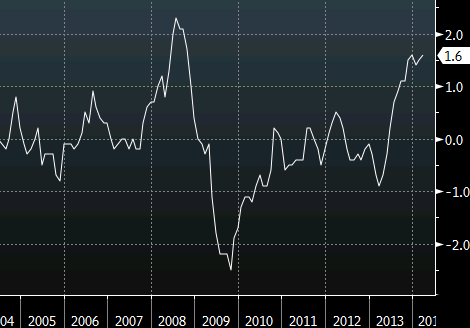One of the main events on the calendar in the week ahead is the release of BOJ inflation forecasts.
Current forecasts:
- 2014 FY 1.3%
- 2015 FT 1.9%
- 2016 – no estimate
The BOJ’s stated goal right now is to bring inflation back to 2% in two years.
The WSJ reported last week that the 2014 forecast could actually be hiked. Higher inflation forecast would severely hurt expectations of mroe BOJ action this year.
The story said a key factor would be the April data for Tokyo. It was released today and showed a 2.9% y/y increase compared to 3.0% expected.
Reuters reports that the forecast for this year is unlikely to change but that the central bank is confident of hitting targets:
In the new projections due on April 30, the BOJ will likely keep its inflation forecast for fiscal 2015 roughly unchanged from the current 1.9 percent. The central bank is also set to estimate fiscal 2016 inflation close to 2 percent, signaling that it is optimistic of achieving sustained price rises over a longer time frame, sources have told Reuters.
In data released Friday the national CPI reading was 1.3% y/y for March compared to 1.4% expected but the key is April, when the consumption tax hike went into effect.
The numbers slightly raise the chance of BOJ action but probably won’t dissuade officials who see inflation on the rise.

Japan national CPI y-y march
The BOJ has repeatedly passed up opportunities to signal a dovish bias and now “a person familiar with the bank’s thinking” cited by the WSJ says higher inflation is what some at the central bank are watching.
While many market analysts say the central bank will fall short of its target of 2% inflation by spring next year, some BOJ officials are even becoming worried about inflation rising too quickly.
Those officials are “a bit concerned about upside risks” to prices, a person familiar with the bank’s thinking.
So far the BOJ has defied private economists and that will continue. Former BOJ member Suda summed it up last week saying the central bank is likely to refrain from adding stimulus as long as possible.
Coming into the year, a favorite trade was to sell the yen on expectations of easing. Those expectations continue to be dampened and the yen is one of the top performers this year and the best G8 currency this month. There is talk that official channels are buying USD/JPY to limit the downside. If so, that’s a factor that can’t last forever.



